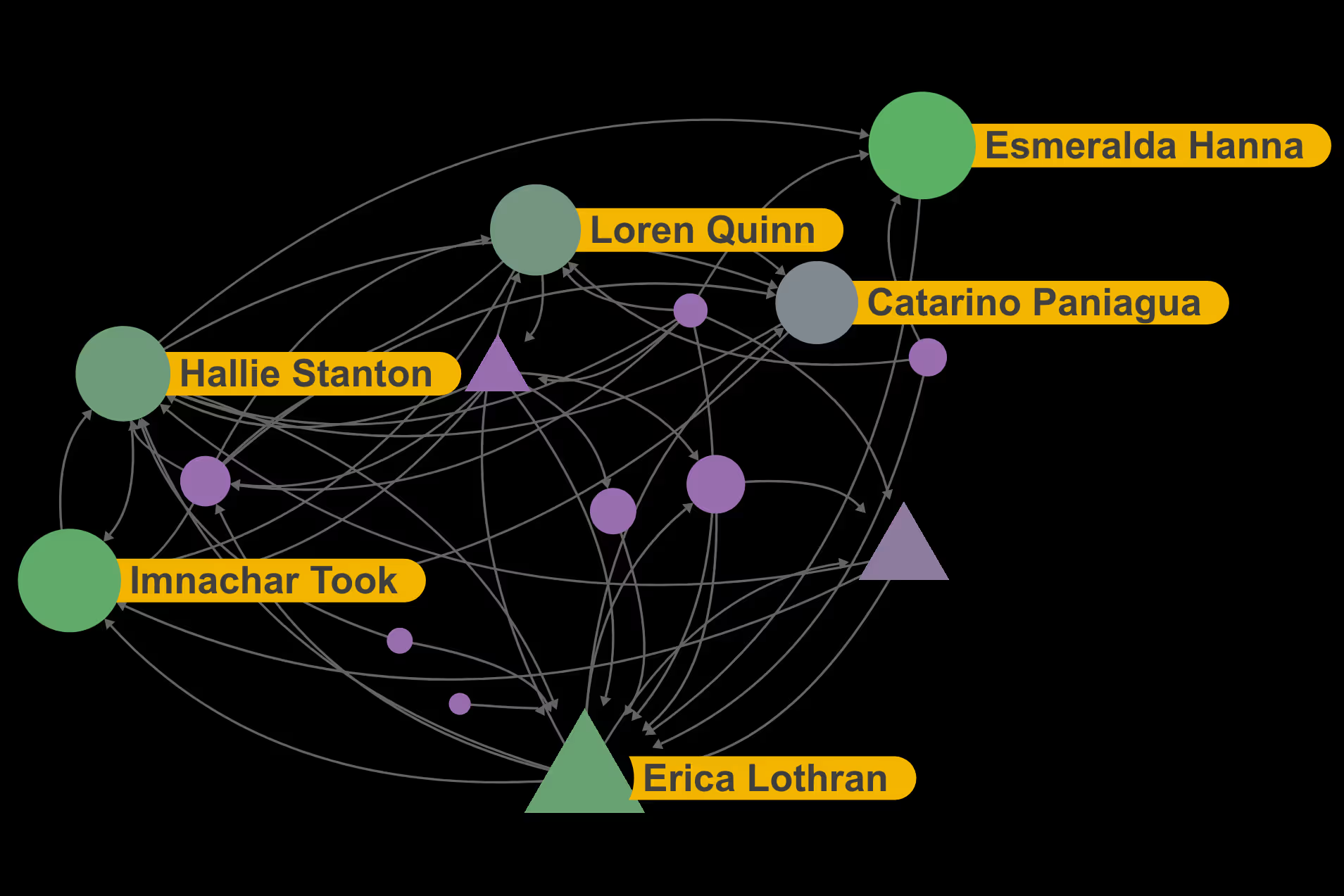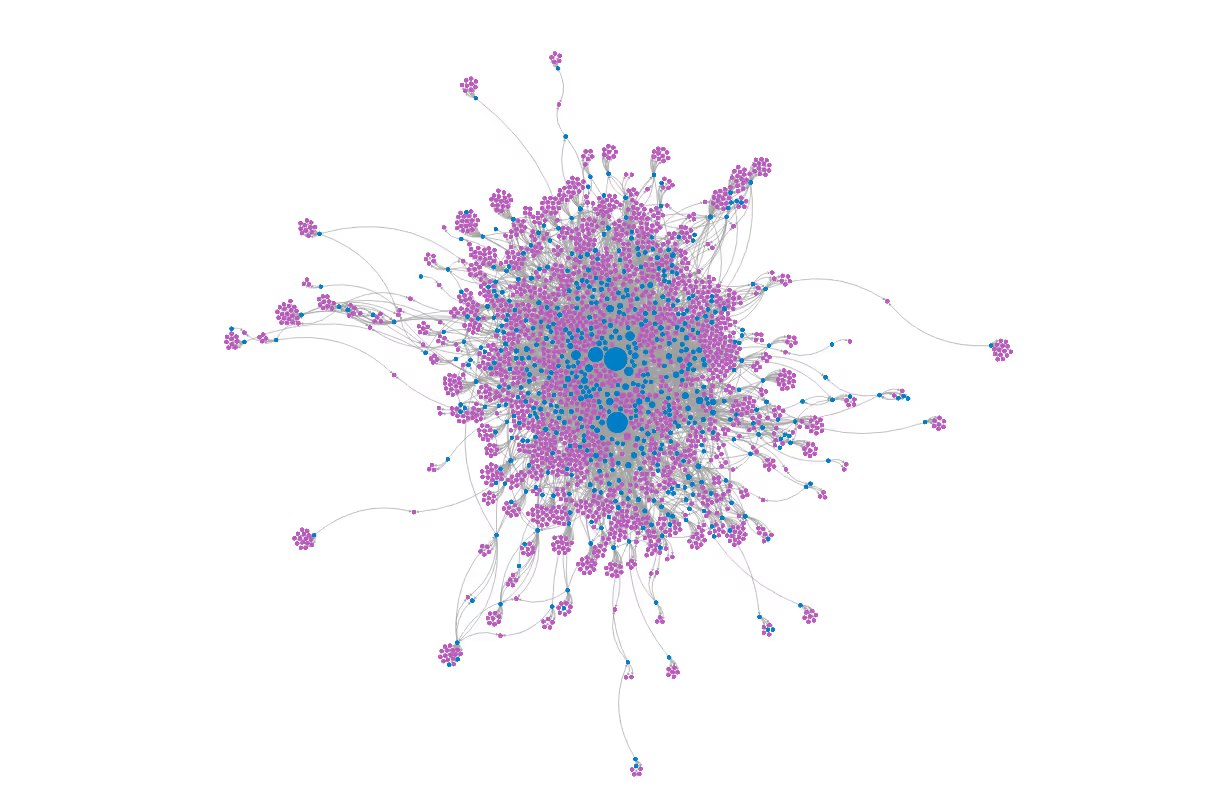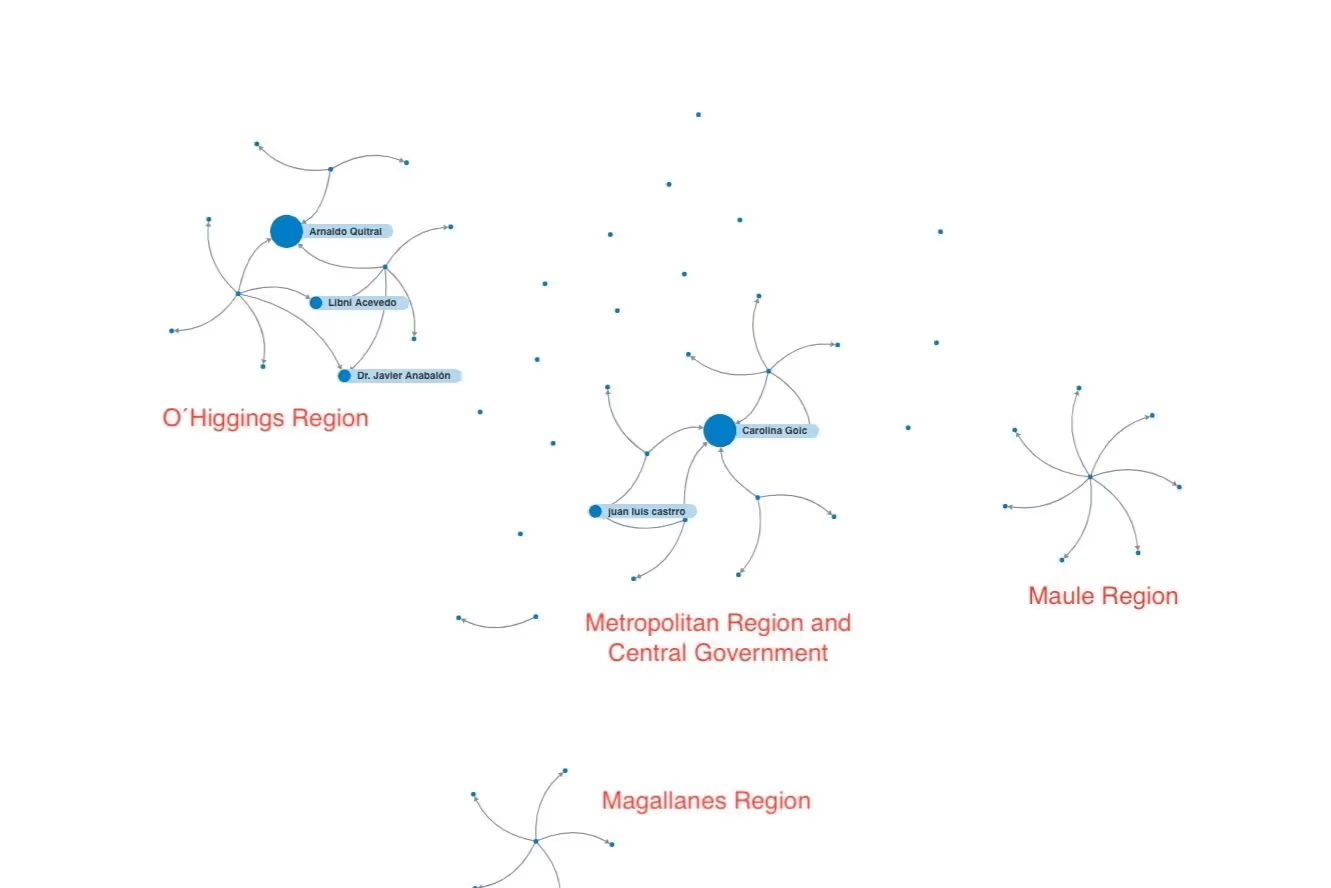This is a guest blog post by Dr Peter Mellalieu. Peter is a Data Analyst Consultant at CATALYNK, where he works with a range of clients to drive their knowledge management and collaborative problem-solving programs using tools from Network Science, Organization Development, and Operations Research. Prior to joining CATALYNK, Peter held roles in software platform development, industrial systems engineering, product development, and academic positions in the USA, United Kingdom, Botswana, Belgium and currently New Zealand.
Introduction
Knowledge-Centered Service (KCS) is a well-established methodology aimed at revolutionizing organizational approaches to knowledge management, especially within customer service. Developed by the Consortium for Service Innovation, KCS embeds knowledge creation and sharing directly into the problem-solving workflow, creating a framework often described as ‘solve and evolve’. Unlike traditional models that rely on specialized knowledge management roles, KCS enables service agents to capture, structure, and refine content in real time as they resolve issues, ensuring that each interaction contributes to a constantly evolving knowledge base.
Central to KCS is the idea that knowledge management becomes a fundamental responsibility within every employee’s role, not a separate function. As agents address customer inquiries, they document solutions and insights, creating a resource that is continuously updated and improved over time. This process enhances response times, elevates the quality of customer interactions, and boosts agent engagement and satisfaction. KCS is a dual-loop process, Figure 1, where both individual problem resolution and organizational learning occur. The dual-loop process ensures the knowledge base remains agile and accurate, turning it into a vital asset for ongoing improvement, product development, and strategic decision-making across the organization.

1. The Role of ONA in KCS Adoption: Why It Matters
KCS provides a structured approach to integrating knowledge capture into customer service operations. However, one key challenge is identifying individuals who can act as KCS coaches, guiding the process of KCS adoption and ensuring its long-term success. Over many years of experience helping organizations adopt KCS-based knowledge management, we know that the ideal competencies of a successful coach are those summarized in the table below. This is a demanding requirement!
Coach selection is where Organizational Network Analysis (ONA) plays a vital role. By using data to map the informal connections within an organization, ONA identifies not only well-regarded technical experts but also those who hold influence and trust within their teams. These individuals are often central to knowledge-sharing networks, making them ideal candidates for KCS coaching.
ONA also uncovers hidden influencers who might otherwise go unnoticed through traditional methods of coach selection. The ONA approach allows organizations to select coaches based on their real impact on knowledge flow, thereby improving the effectiveness of KCS adoption.
2. How to Select the Right KCS Coaches Using ONA
Our process for selecting KCS coaches is deeply informed by ONA, ensuring that the best individuals are chosen for this critical role. CATALYNK’s methodology follows a step-by-step workflow, Figure 2.
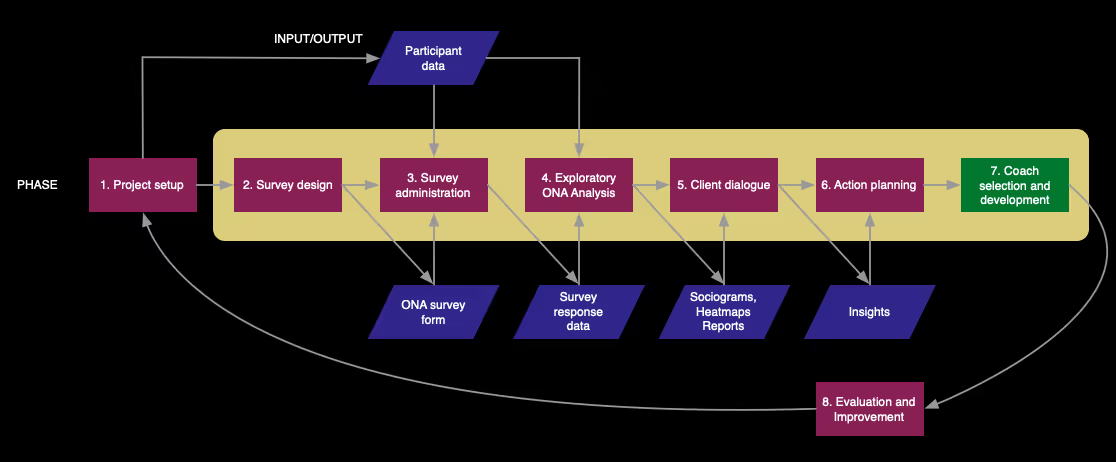
- Project Setup: The first phase involves setting clear terms of reference for using ONA in coach selection.
- Survey Design & Administration: A carefully designed ONA survey is sent to employees, asking them to nominate individuals who help them succeed in their roles. These nominations help map key influencers in knowledge sharing. We also survey several measures of collaborative health (such as psychological safety) and seek qualitative feedback about the strengths and weaknesses of the organization’s approach to knowledge management and customer support.
- Candidate Metrics and Merit Calculation: We calculate a Candidate Merit score for each potential coach. Metrics like interaction frequency, support provided, and approachability are weighted to determine who is most suited for the role. Key metrics are adjusted based on organizational needs, ensuring an evidence-based and data-driven selection process.
- Exploratory ONA and Client Dialogue: Data from the survey is used to create network diagrams, which visualize relationships between staff members. These visual maps highlight individuals who are most central to knowledge-sharing activities. The data is then discussed with management to finalize the selection process.
3. Case Study: Using ONA for Coach Selection and Training
A large multinational enterprise, which we will refer to as SuperCorp, sought to improve its support practices through KCS adoption. The organization faced challenges in selecting the right KCS coaches, as previous efforts based on management selection alone led to limited success. CATALYNK was brought in to apply ONA for selecting the optimal coaching candidates.
- Survey and Network Analysis: A survey was conducted across SuperCorp’s three regions and 200 support staff. The Polinode ONA platform was used to map the relationships between employees across several dimensions. The analysis also revealed a select group of key influencers in different regions.
- Candidate Pool: The ONA analysis produced a Candidate Pool, a select group of 40 individuals most suited for coach development based on their Candidate Merit scores, Figure 3. Candidates like Esmeralda scored highly across multiple metrics, including being sought after for greater access, providing support, and being highly approachable. The selection of factors and their weight is informed by the best practice for coach selection advised by the Consortium for Service Innovation in KCS Coaching Program - Consortium for Service Innovation.

- Candidate Selection and Influencers. The final selection of the 35 coaches to be trained, drawn from the Candidate Pool, was negotiated between SuperCorp managers and CATALYNK’s coach trainer. Factors additional to the ONA that informed the final selection included managers’ knowledge of candidate workload, forthcoming promotions or resignations, candidates’ completion of comprehensive KCS practice training, and diversity considerations. The network diagram, Figure 4, clearly illustrates the relative Candidate Merit relative to all employees in the region. Furthermore, this network diagram highlights those employees, such as Erica, who are likely to be highly influential in communicating the benefits of the KCS program across the region. Together, they are highly connected ‘bridges’ to 90 percent of the region’s employees.
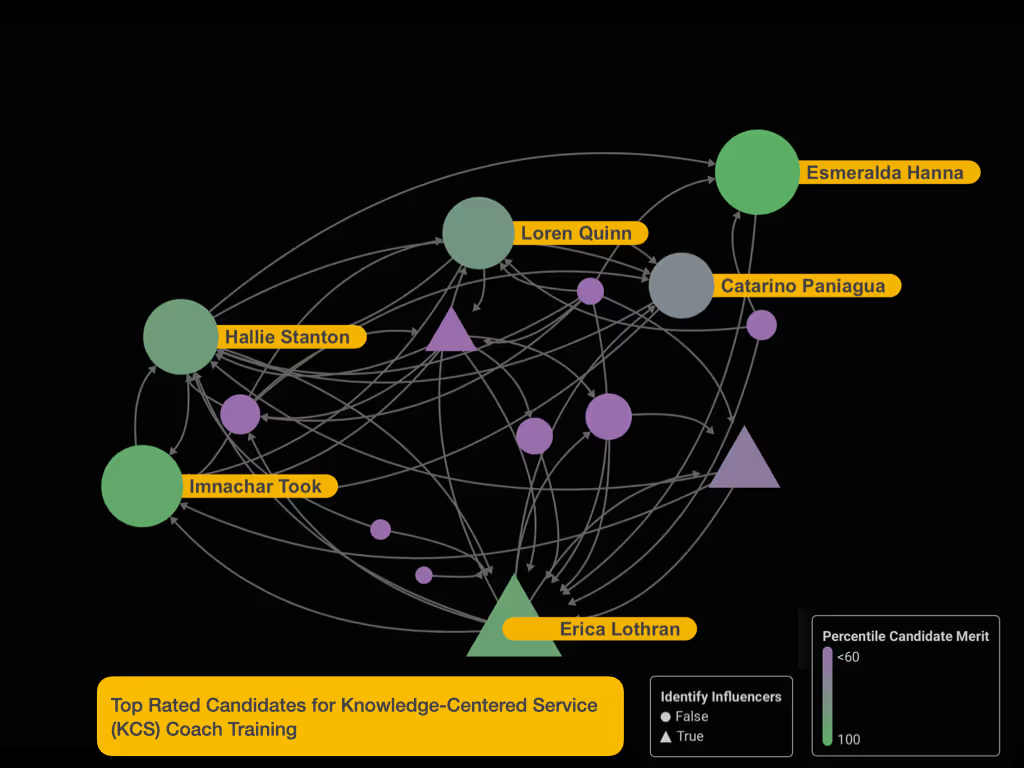
- Outcome: The selected candidates underwent KCS training, and the results showed faster adoption rates and improved knowledge sharing across the region. The ONA approach ensured that the selected coaches were not just technically proficient but also had the social capital necessary to influence and support their peers. The enterprise subsequently embarked on a coach training program for the remaining regions confident in the approach taken to identify the most promising coach candidates.
- Evidence-based support: Our outcome aligns with the findings of the Consortium for Service Innovation that “when training is combined with coaching, individuals increase their productivity by an average of 86% when compared to 22% with training alone. The speed at which organizations realize the benefits of KCS is directly related to the speed at which the Solve Loop behaviors become a habit for the knowledge workers. Coaching is how we increase the speed of adoption and maximize the benefits.”
4. Key Takeaways and Best Practices for Using ONA in KCS Adoption
- Start with ONA Early in the Process: Implementing ONA at the outset of a KCS Adoption Program allows organizations to base their coach selection on data rather than intuition, improving the chances of a successful KCS adoption.
- Focus on Influence, rather than Expertise: When selecting coaches, it’s essential to prioritize individuals who are trusted and influential within their teams. These are the people who can drive the adoption of KCS practices.
- Continuous Evaluation: Periodic ONA assessments should be conducted to ensure that selected coaches remain effective and that new candidates can be identified as organizational dynamics evolve. Evaluation is equally essential to fine-tune the weightings used to determine Candidate Merit.
- Conduct comprehensive organizational assessment: Combine the ONA survey with a Collaborative Health Analysis to add further precision for focussing on addressing organizational weaknesses and leveraging unique strengths for program adoption.
- Use an integrated survey and analysis platform: Polinode’s integrated survey and network analysis features provided CATALYNK with a productive, one-stop platform for administration and investigation revealing powerful insights and effective presentation of results, Figure 5.

Conclusion
Organizational Network Analysis offers a strategic advantage in KCS adoption by ensuring that the right people are selected as coaches and influencers. Through data-driven insights, CATALYNK has helped organizations like SuperCorp identify and train coaches who drive successful KCS adoption. By leveraging ONA, organizations can optimize their knowledge management efforts, leading to more effective customer support, customer self-service and continuous improvement. An early, modest investment in ONA, coupled with an assessment of Collaborative Health, ensures that the later, more substantial investments in KCS roll-out, coach training, coach deployment are well-focussed and timely, and deliver results with a high benefit to cost ratio.
Knowledge-Centered Service (KCS®) is a registered trademark of the Consortium for Service Innovation™.
CATALYNK gratefully appreciates the assistance of Polinode in supporting its conduct of Organizational Network Analysis.
SuperCorp is a real but disguised enterprise. Data selected for illustrative purposes.
Further reading
- Consortium for Service Innovation. (2020). KCS Principles and Core Concepts. https://library.serviceinnovation.org/
- Consortium for Service Innovation. Coaching for Success. https://library.serviceinnovation.org/KCS/KCS_v6/KCS_Principles_and_Core_Concepts/030/090
- Dixa. (2022). Quick Guide to Knowledge-Centered Service. https://www.dixa.com/blog/quick-guide-to-knowledge-centered-service/



